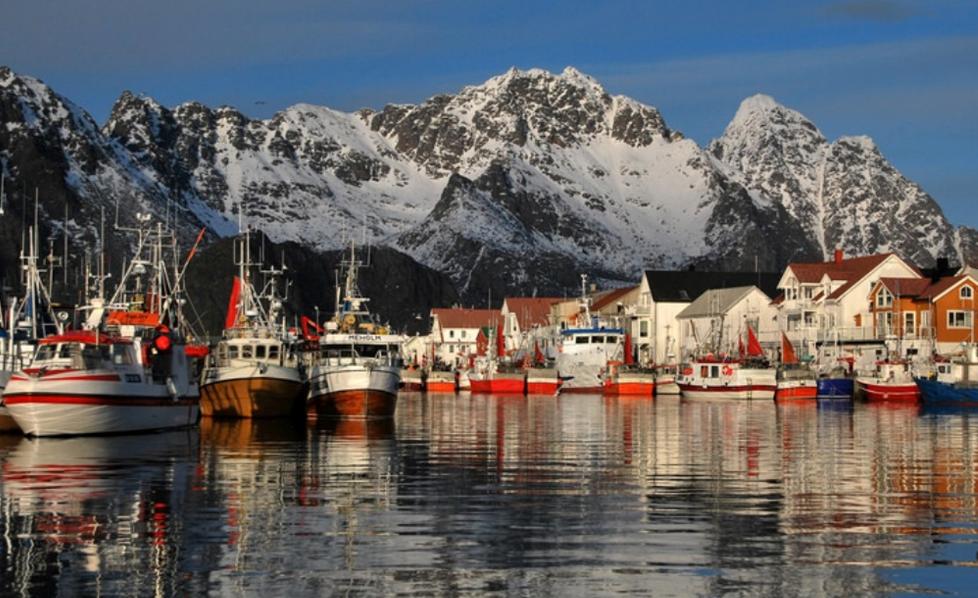Norway is a big country. Oslo, the capital is in the south. Trondheim is 500 kilometres to the north. For a time it was the capital of Norway but now it is content to be a progressive city with a rich cultural life.
You need to be dedicated to go north from here by car. It is nearly 2,000 km from Trondheim to Kirkenes near the Russian border and if you stay in Norway there is only one main road so you have to return pretty much the way you went. We were dedicated.
Hell
Our first stop north of Trondheim is Hell. If you are game, you can buy a one-way train ticket to Hell from Trondheim. The railway station is one of the most photographed in Norway because of its signage. You can buy a postcard which reads “Hell – have a good journey”. We did. In winter, Hell freezes over, reaching sub-Arctic temperatures. The town has a Blues in Hell music festival in September.
Across the Arctic Circle
The E6 highway winds north past mountains and through towns. Some like Mo-i-Rana have populations of over 20,000 and there are attractions like glaciers and national parks to see.
The Polar Circle Center on the Arctic Circle, is an obvious stop although it is really a tourist trap. There is a tourist information office, a movie theatre, post office, souvenir shop, and restaurant.
North again is the fast-growing city of Bodø with about 50,000 residents which is situated on a peninsula on a beautiful stretch of coastline. The city is a major education and training center with its University of Nordland.
Lofoten Islands

These islands consist of mountains, sheltered inlets, stretches of dramatic seashore, and large virgin areas in a wild ocean. Due to the warm Gulf Stream, Lofoten has a much milder climate than other parts of the world at the same latitude but there is no getting away from the fact that it rains a lot. Lofoten offers striking scenery, and lovely small villages. Colorful fishing boats add to the charm.
We take the car ferry from Bodø to Moskenes (approx. 3.5 hours) which is close to the southern end of the main island. This has a dramatic backdrop of jagged peaks and we soon discover that most Lofoten towns have a similar setting. Over the next few days we explore cute villages, enjoy striking scenery, and experience life in a dramatically different environment.
Alta

People have lived here for more than 10,000 years. The major site of interest is the Alta Museum. There is an excellent indoor exhibition explaining the local rock art and giving a broader introduction to Finnmark’s prehistory. The exhibition also teaches us that in the Sámi (Laplander) religion, nature was regarded as possessing a soul and being alive.
Alta Museum is linked by boardwalk to a UNESCO World Heritage Rock Carving site where there is a series of carvings from up to 7,000 years ago. These are extensive and took an hour to enjoy. Approximately 3,000 figures have been found here making it one of the largest collections in Europe.
Experience the Sámi culture
The bleak country south and east of Alta is the home of the indigenous Nordic people, Sámi reindeer-herders. Frankly, it is only the Sámi culture that is of great interest here and this can be depressingly difficult to see in the middle of summer when many Sámi have moved to the coastal pastures. The best time to visit is during the Easter festival when there are concerts, church services, and traditional sports.
Kautokeino is a permanent town and the principal winter camp of the Sámi people but it is a somewhat desolate place strung out along the highway. Karasjok is the capital of the Sámi and is more organized than Kautokeino. It is only 18 km from the Finnish border and here we find the Sámi parliament and several museums and attractions.
North Cape
North Cape/Nordkapp is touted as the most northern point of continental Europe. Near North Cape there are several alternatives. Skarsvag, the nearest fishing village, has boat trips, fishing, bird-watching, and whale safaris. Cycle and kayak rental is also available. In the same area, the Church Gate rock formation offers excellent views of North Cape, the Horn, and the mid-night sun.
North Cape has been a visitor attraction for several hundred years. You can only enter this area after paying a fairly hefty fee but we found it worthwhile. Outside you can see the King Oscar Monument which was built in 1873 to mark the outermost limit of the Norway-Sweden union. The Globe monument erected in 1977 has become the symbol of the North Cape and is a popular photographic spot.
North Cape Hall is a large tourist center with a host of facilities including a film on a wrap-around screen about the four seasons. The Tunnel has exhibitions about the North Cape’s long history as a tourist destination and this leads to St Johannes Chapel which is the world’s northernmost ecumenical chapel.
Nearby is a Thailand Museum because this spot was visited by King Chulalongkorn more than 100 years ago. Finally, we reach the Cave of Light which is a new attraction providing a journey through the seasons by way of sound and light.
Images: Phensri Rutledge


















